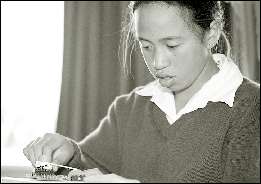|
|
|
The analyses of the relative performance of subgroups used an overall score for each task, created by adding scores for the most important components of the task. Where only two
subgroups were compared, differences in task performance between the
two subgroups were checked for statistical significance using t-tests.
Where three subgroups were compared, one way analysis of variance was
used to check for statistically significant differences among the three
subgroups. For the first four of the nine demographic variables, few statistically significant differences among the subgroups were found. For the remaining five variables, statistically significant differences were found on substantial numbers of tasks. Details are presented below. Zone For year 8 students, there were no statistically significant differences among the three subgroups on any of the 17 tasks. There was a statistically significant difference among the three subgroups on one question of the Technology survey. In response to question 4, Auckland students reported the highest level of use of computers when not at school and students from elsewhere in the North Island reported the lowest use. For year 4 students, there was a statistically significant difference among the three subgroups on only one of the 15 tasks. Students from Auckland score highest and students from elsewhere in the North Island score lowest on Gift soap. There were no statistically significant differences among the three subgroups on questions of the Technology survey. Community
Size For year 8 students, there were no statistically significant differences among the three subgroups on any of the 17 tasks, but there was a difference on one question in the Technology survey. Students from main centres reported the highest level of computer use outside of school (question 4), while students from rural areas reported the lowest level of use. For year 4 students, there were no statistically significant differences among the three subgroups on any of the assessment tasks, or on questions of the Technology survey . School
Size For year 8 students, there was a statistically significant difference among the three subgroups on only one of the 17 tasks. Students from small schools scored lowest on Planning a Class Event. There was also one statistically significant differences among the three subgroups on a question of the Technology survey. Students from small schools reported less use of computers outside of school (question 4). For year 4 students, there were no statistically significant differences among the three subgroups on the assessment tasks, or on questions of the Technology survey. School
Type Gender For year 8 students, there were statistically significant differences between boys and girls on three tasks. Girls scored higher than boys on two design tasks: Sports Bag and Link task 5. However, girls scored lower than boys on a task involving electrical circuits: Link task 2. On the Technology survey, there were statistically significant differences between boys and girls on three of the four questions, with boys higher in each case. Boys expressed greater liking for doing technology at school (question 1), judged themselves to be performing better in technology (question 2), and reported a greater level of computer usage outside of school (question 4) For year 4 students, there were statistically significant differences between boys and girls on three tasks. Girls scored higher than boys on one design task (Gift soap), but lower than boys on another design and making task (Flag). Girls also scored lower than boys on a task involving understanding how a technological device works (Stapler). There were also statistically significant differences on two questions of the Technology survey. Compared to girls, boys reported greater usage of computers both at school (question 3) and outside of school (question 4). Socio-Economic
Index For year 8 students, there were statistically significant differences among the three subgroups on seven of the 17 tasks. In each case, performance was lowest for students in the low SES group. Students in the high SES group generally performed better than students in the medium SES group, but in some cases these differences were small. Because of the number of tasks, the specific tasks will not be listed here, but it should be noted that they included tasks in three of the four strands assessed (Chapters 3 to 5). On the Technology survey, there was a statistically significant difference on one question: students from low SES schools reported lower levels of use of computers outside of school (question 4). For year 4 students, there were statistically significant differences among the three subgroups on five of the 13 tasks: Useful Machines, Stapler, Link task 1, Link task 3, and Space game. In each case, performance was lowest for students in the low SES group and highest for students in the high SES group. There were no statistically significant differences among the three subgroups on questions of the Technology survey. Student
Ethnicity For year 8 students, there were statistically significant differences of performance between Mäori and non-Mäori students on three tasks. In each case, non-Mäori students scored higher than Mäori students. These three tasks were Link task 1, Gift soap, and Link task 6. There were no statistically significant differences between Mäori and non-Mäori students on questions of the Technology Survey. For year 4 students, there were statistically significant differences in performance on two tasks. Mäori students scored lower than non-Mäori students on both tasks: Link task 1 and Link task 3. There were no statistically significant differences between Mäori and non-Mäori students on questions of the Technology survey. Proportion
of Mäori Students
in Schools For year 8 students, statistically significant differences in performance among the three subgroups were found on seven of the 17 tasks. On each of these tasks, students attending schools with less than 10 percent Mäori students scored highest. Because of the number of tasks involved, they will not be listed here, but it is worth noting that all seven tasks involved individual students rather than teams of students. On the Technology Survey, there was a statistically significant differences between the three subgroups on one question. Students from schools with less than 10 percent of Mäori students reported higher levels of use of computers outside of school (question 4). For year 4 students, statistically significant differences in performance between the three subgroups were found on four of the 15 tasks, all involving individual performance. In each case, students attending schools with more than 30 percent Mäori students scored lowest, with generally smaller differences between the other two subgroups. The four tasks were: Tool time, Stapler, Link task 1, and Link task 3. There were no statistically significant differences on questions of the Technology Survey. Proportion
of Pacific Island Students in Schools For year 8 students, statistically significant differences in performance among the two subgroups were found on five of the 20 tasks: Tool time, Gift soap, Link task 3, Link task 5, and Green sheep, . For each of these tasks, average performance levels were lower in the schools with more than 5 percent Pacific Island students. There were no statistically significant differences on questions of the Technology survey. For year 4 students, statistically significant differences in performance among the two subgroups were found on two individual tasks (Stapler and Link task 1)and two team tasks (Coloured sheep and Link task 7. For each of these tasks, average performance levels were lower in the schools with more than 5 percent Pacific Island students. There were no statistically significant differences on questions of the Technology survey. |
|
| [ top of the page ] | |
 Because the number of
students included in each analysis was quite large (approximately 450),
the statistical tests were quite sensitive to small differences. To reduce
the likelihood of attention being drawn to unimportant differences, the
critical level for statistical significance was set at p = .01 (so that
differences this large or larger among the subgroups would not be expected
by chance in more than one percent of cases). The critical level was adjusted
to p = .05 for the six tasks where differences in team performance among
120 teams were being examined.
Because the number of
students included in each analysis was quite large (approximately 450),
the statistical tests were quite sensitive to small differences. To reduce
the likelihood of attention being drawn to unimportant differences, the
critical level for statistical significance was set at p = .01 (so that
differences this large or larger among the subgroups would not be expected
by chance in more than one percent of cases). The critical level was adjusted
to p = .05 for the six tasks where differences in team performance among
120 teams were being examined. 